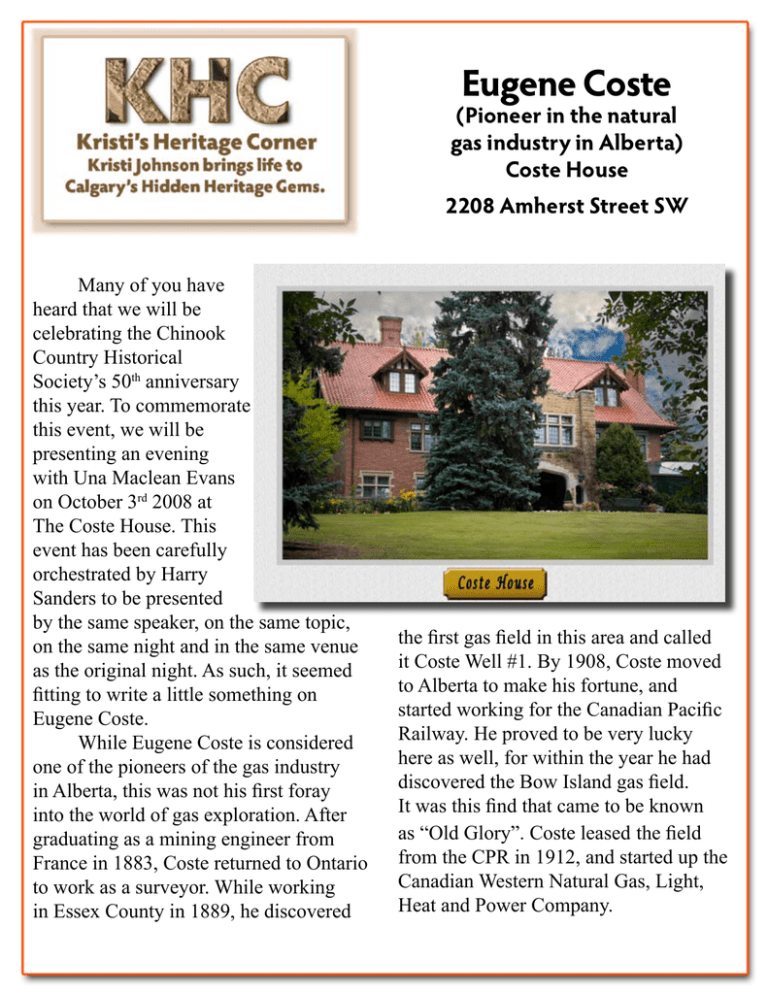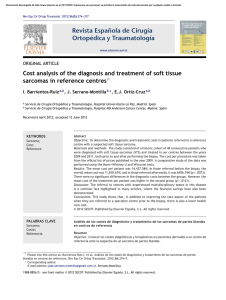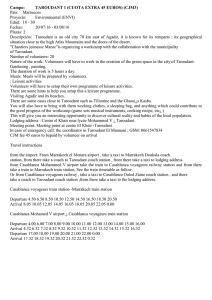Eugene Coste - Chinook Country Historical Society
Anuncio

Eugene Coste (Pioneer in the natural gas industry in Alberta) Coste House 2208 Amherst Street SW Many of you have heard that we will be celebrating the Chinook Country Historical Society’s 50th anniversary this year. To commemorate this event, we will be presenting an evening with Una Maclean Evans on October 3rd 2008 at The Coste House. This event has been carefully orchestrated by Harry Sanders to be presented by the same speaker, on the same topic, on the same night and in the same venue as the original night. As such, it seemed fitting to write a little something on Eugene Coste. While Eugene Coste is considered one of the pioneers of the gas industry in Alberta, this was not his first foray into the world of gas exploration. After graduating as a mining engineer from France in 1883, Coste returned to Ontario to work as a surveyor. While working in Essex County in 1889, he discovered the first gas field in this area and called it Coste Well #1. By 1908, Coste moved to Alberta to make his fortune, and started working for the Canadian Pacific Railway. He proved to be very lucky here as well, for within the year he had discovered the Bow Island gas field. It was this find that came to be known as “Old Glory”. Coste leased the field from the CPR in 1912, and started up the Canadian Western Natural Gas, Light, Heat and Power Company. With the success of his company, Coste purchased two lots in the Mount Royal District. The home he built there was complete around 1912. The two acre lot included a 28 room mansion, coach house, dower house for Coste’s mother in law and a large greenhouse. The interior of the house was no less elaborate. Wood panels around the home were a selection of oak, mahogany or walnut. Marble and tile throughout the home were all imported from Europe. Mirrors were gilded and the chandeliers were all crystal. Not surprisingly, the house was fitted to accommodate natural gas heating. It is probably worth mentioning the Coach House as it was an interesting structure in and of itself. The coach house was designed to complement the main structure, albeit on a smaller scale. This structure was dual purpose as it served as the storage facility for the family car as well as the chauffeur’s residence. The Coach House was equipped with a gas pump, grease pit and all the amenities for long term residence (kitchen, bathroom, living room and bedroom). In its day, the Coach House was a rarity even by Mount Royal standards. The structure was only one of two storage facilities for automobiles in Mount Royal. Most of the other residents of the area had the more traditional horse drawn carriage houses. The Coste’s chauffeur, Lancelot Dobson, remained in their employ throughout their time in Calgary. Even after the family had left for Toronto, Lancelot continued to live in the Coach House. In fact, he remained there until 1935 when the City of Calgary took over the property. Eugene Coste left Calgary for Toronto in 1922 after the death of his son. He offered his home to the City of Calgary in the hopes that it would be used as a children’s hospital. The City did not take him up on this offer, and until 1946 the house was used as a residence, a museum to house the Civic Museum’s artifacts and as the site for the Provincial Institute of Technology and Art. After World War II, The City Planning Commission recommended that the Coste House be demolished and the land subdivided. The Calgary Art Association, with the help of Lawyer J.E.A. Macleod, convinced the City to preserve the house and use it as a cultural centre. They rented the house from the City for $100 a month. During their stay, the Coste House became a haven for artists and social events. St. Hilda’s School for Girls held their “Governors Ball” at Coste House, and the students could listen to music and dance from 8:30 till 1:00. One of the pictures in the Glenbow’s photographic archive shows a young Peter Lougheed cutting a rug with the girls from St. Hilda’s. (See the Glenbow website and search for Peter Lougheed in the photographs section.) The house also hosted tea parties where artists such as John Snow and Max Bates would attend. There was a grand costume party at the house to celebrate Alberta’s golden jubilee. The Coste House even had a Junior Theatre and Children’s Choir that would rehearse in the house. While Eugene Coste passed away in Ontario, his legacy is remembered in many ways throughout Calgary. Coste was one of the early members of the Canadian Mining Institute, the Calgary Board of Trade, the Calgary Golf Club and the Ranchmen’s Club. The Eugene Coste Elementary School in Haysboro was named in his honour in 1959, and is still functioning in this capacity today. We would like to think that he would have been pleased to know that his home was still a venue for social and cultural events, such as the one that CCHS is so pleased to be sponsoring in October. Research Material courtesy of: The Calgary Public Library, “Home Sweet Heritage Home: Biographies of Famous Calgarians and their Homes” and “Cornerstones”. The Glenbow Archives




